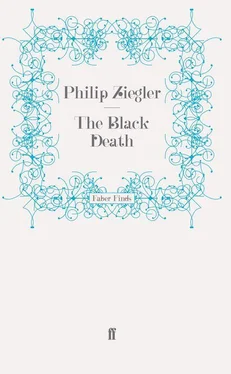• Annales Matseenses, Mon. Germ. Hist., IX.
• Henrici de Hervordia, ed. Potthast, Göttingen, 1859.
• Continuatio Novimontensis, Mon. Germ. Hist., IX, p. 675.
• Heinrici Rebdorfensis Annales Imperatorum, F.R.G., Vol. IV, pp. 532–8.
British Isles
• Robert of Avesbury, Continuatio Chronicarum de Gestis Mirabilibus Regis Ed. III., ed. E. M. Thompson, R.S. 93.
• Thomas Walsingham, Historia Anglicana, ed. H. Riley, R.S. 28.
• Polychronicon Ranulphi Higden, ed. J.R. Lumby, R.S. 41, VIII.
• Eulogium ( Historiarum sive Temporis ), ed. F. Haydon, R.S. 9, III.
• John Capgrave, The Chronicle of England, ed. F. Hingeston, R.S. 1.
• Chronicon Henrici Knighton, ed. J. Lumby, R.S. 92, II.
• Gesta Edwardi de Carnavan, Auctori Canonico Bridlingtoniensi cum Continuatione, ed. W. Stubbs, R.S. 76, II.
• Chronicon Galfridi Le Baker de Swynebroke, ed. E. M. Thompson, Oxford, 1889.
• Chronicon Johannis de Reading, ed. J. Tait, Manchester, 1914.
• Willelmi de Dene, Historia Rossensis, Wharton, Anglia Sacra, Vol. I, p. 356; cf. B. Mus. Cotton M. S., Faust B. V, p. 96.
• Stephen Birchington, Vitae Archiepiscoporum Cantuariensium, Wharton, Anglia Sacra, Vol. 1, p.1.
• ‘A Fourteenth Century Chronicle from the Grey Friars at Lynn’, ed. A. Gransen, Eng. Hist Rev., Vol. LXXII 1957, p. 270.
• Chronica Monasterii de Melsa, R.S. 43, III.
• Historical Papers from Northern Registers, ed. J. Raine, R.S. 61.
• Eynsham Cartulary, ed. H. E. Salter, Ox. Hist. Soc, Oxford, 1907–8.
• Chronicle of Louth Park, line. Rec. Soc, 1891.
• John Clyn, Annalium Hiberniae Chronicon, ed. R. Butler, Irish Arch. Soc., Dublin, 1849.
• Chronicle of John of Fordun, ed. W. F. Skene, Edinburgh, 1872.
• Cronykil of Andrew of Wyntoun, ed. D. Laing, Edinburgh, 1872.
• Book of Pluscarden, ed. F. J. Skene, Edinburgh, 1880.
Other Countries
• Continuatio Chronici Guillelmi de Nangiaco, Soc. de L’Histoire de France, II, 1844, p. 211.
• Chronicon Pragense, ed. Loserth, Fontes Rerum Austriacarum, Vol. I.
• Breve Chronicon Clerici Anonymi, De Smet, Recueil des Chroniques de Flandres, Vol. III, p. 5.
• Chronicon Majus Aegidii Li Muisis, De Smet, ibid, Vol. II, p. 110.
• C. S. Bartsocas, ‘Two 14th Century Greek Descriptions of the Black Death (Nicephoros Gregoras and Emperor John Cantacuzenos)’, Journ. Hist. Med., Vol. XXI, 1966, No. 4, p. 394.
Finally there are the plague tractates left by the doctors and savants of the period. Almost all those listed below were analysed by Anna Campbell in her invaluable study The Black Death and Men of Learning.
• Master Jacme d’Agramont, Sudhoff, Archiv für Geschichte der Medizin, XVII, (1925), 120–21.
• (Klebs, A. C., ‘A Catalan Plague Tract of April 24, 1348’, 6ème Congrès International d’Histoire de la Médecine, Anvers, 1929, pp. 229–32.)
• Gentile da Foligno, Sudhoff, Archiv V (1913), 83–6, 332–7. A. Philippe, Histoire de la Peste Noire, (Paris, 1853) contains another text
• John of Penna, Sudhoff, Archiv V (1913), 341–8, and Archiv XVI, (1924) pp. 162–7.
• Paris Faculty of the Colleges of Medicine, ( Compendium de Epydimia ); Brit. Mus. Harl., 3,050, (XVII), p. 66 recto (b) to p. 68 verso (b); H. E. Rebouis, Étude historique et critique sur la peste, Paris, 1888. (D. W. Singer, ‘Some Plague Tractates’, Proc. Roy. Soc. Med., Vol. IX, Pt. 2, p. 159.)
• Master Albert, Sudhoff, Archiv VI, 316–17.
• Alfonso de Cordoba, Sudhoff, Archiv III, 224–6.
• Abū Ja’far Ahmad Ibn ’Ali Ibn Muhammad Ibn ’Ali Ibn Khātimah (referred to generally as Ibn Khātimah). Translated into German in Sudhoff, Archiv XIX (1927), by Taha Dinānah, pp.27–81.
• John Hake of Göttingen, Sudhoff, Archiv V, 37–8.
• The Five Doctors of Strasbourg ( Treasure of Wisdom and of Art ), Sudhoff, Archiv XVI (1924).
• (E. Wickersheimer, ‘La Peste Noire à Strasbourg et le regime des cinq médecins strasbourgeois’, 3 ème Congrès International d’Histoire de la Médecine, Antwerp, 1923, pp.54–60.)
• Author of ‘Utrum Mortalitas…’ (‘Is it from Divine Wrath that the Mortality of These Years Proceeds?’), Sudhoff, Archiv XI, 44–51. Ascribed by S. Guerchberg (‘La controverse sur les prétendus semeurs de la Peste Noire’, Revue des Études Juives, Vol. VIII, p. 3, 1948) to Konrad de Megenberg.
• Abū ’Abdallah Muhammad Ibn ‘Abdallāh Ibn Sa’īd Ibn Al-Khatīb Lisânal-Din (referred to generally as Ibn al-Khatīb). Translated into German in Sitzungsberichte der Königl. bayer. Akademie der Wissenschafenzu München, II, (Munich, 1863), 1–28 by M. J. Müller.
• Konrad de Megenberg, Buch der Natur, ed. Pfeiffer, 1870.
• Dionysius Colle ( De pestilentia 1348–1350 et peripneumonia pestilentiali ). D. J. Colle, Benonensi, Pisa, 1617, pp. 570–76.
• Author of ‘Primo de Epydimia…’ Sudhoff, Archiv V, (1913) 41–6.
• Simon of Covino, Bibl. de l’École des Chartes (1840–41), ed. E. Littré, Sér 1, Vol. 2, pp. 201–43.
• John of Burgundy (John à la Barbe). (Published 1371 but mainly relating to epidemic of 1348–9.) Ed. D. W. Singer, Proc. Roy. Soc. Med., Vol. 9, Pt. 2, p. 159.
• Guy de Chauliac, La Grande Chirurgie, ed. F. Nicaise, Paris, 1890.
THE BLACK DEATH IN RECENT HISTORIOGRAPHY
It was towards the end of 1969, in the same year that Philip Ziegler’s The Black Death was first published, that the influential French journal Annales: Economies Sociétés Civilisations included a substantial section on ‘Maladies et Mort’, introduced by a survey article by Jean-Noël Biraben and Jacques Le Goff on ‘La Peste dans le Haut Moyen Age’ (pp. 1484–1510). And there then followed a similar concentration on death-related themes in the Revue du Nord for 1983, where Walter Prevenier and other Low Countries specialists – starting with Prevenier’s own paper on ‘La démographie des villes du comté de Flandre aux xiii eet xiv esiècles’ (pp. 255–75) – discussed the comparable experience of the North-West. In the interval, Dr Biraben had presented what is still the most extended historical analysis of the West European plague in his Les hommes et la peste en France et dans les pays européens et mediterranéens (Paris, 1976), and Michael Dols’s valuable study of The Black Death in the Middle East (Princeton, 1977) had been published. More recently, Ole Jorgen Benedictow’s book on Plague in the Late Medieval Nordic Countries (Oslo, 1993) has covered the same ground for Iceland, Scandinavia and Northern Germany. Each of these books contains a comprehensive bibliography of the literature on plague in many languages. What follows is a bibliographical essay on the post-1969 English-language works which may be of interest to new readers of Ziegler’s classic.
The argument about the nature and origins of bubonic plague continues. There have been revisionary books by J. F. D. Shrewsbury, A History of the Bubonic Plague in the British Isles (Cambridge, 1970) and Graham Twigg, The Black Death: a biological reappraisal (London, 1984). And almost everybody now agrees that plague was not the only – nor even (on many occasions) the major – killer in the late-medieval and early-modern West. Robert S. Gottfried reviewed other infections but still gave pride-of-place to plague in his Epidemic Disease in Fifteenth-Century England, The medical response and the demographic consequences (Leicester, 1978), then following that work with a general book on The Black Death. Natural and human disaster in medieval Europe (London, 1983). But smallpox, influenza and typhus earn a more prominent place in Ann G. Carmichael’s Plague and the Poor in Renaissance Florence (Cambridge, 1986), as they do again, with particular emphasis on malaria, in Mary J. Dobson’s Contours of Death and Disease in Early Modern England (Cambridge, 1997). For that later period, see also Paul Slack’s The Impact of Plague in Tudor and Stuart England (London, 1985), and the collected essays in The Plague Reconsidered. A new look at its origins and effects in 16 thand 17 thcentury England, ed. Paul Slack (Local Population Studies supplement, 1977), and in Health, Medicine and Mortality in the Sixteenth Century, ed. Charles Webster (Cambridge, 1979). Other collections of essays include The Black Death. The impact of the fourteenth-century plague, ed. D. Williman (Binghamton, 1982), and Life and Death in Fifteenth-Century Florence, eds. Marcel Tetel, Ronald G. Witt and Rona Goffen (Durham N. C., 1989). And contemporary descriptions of the plague, many in translation for the first time, have recently been collected by Rosemary Horrox, The Black Death (Manchester, 1994), in a useful volume of sources.
Читать дальше












